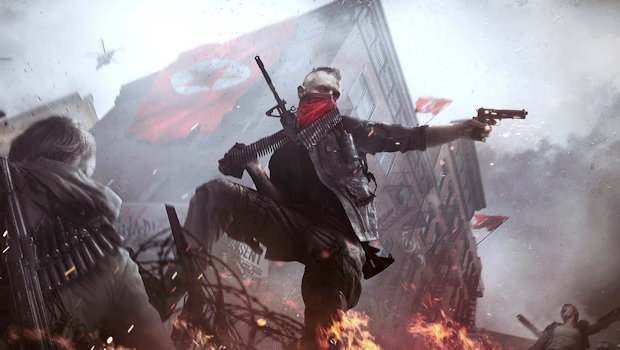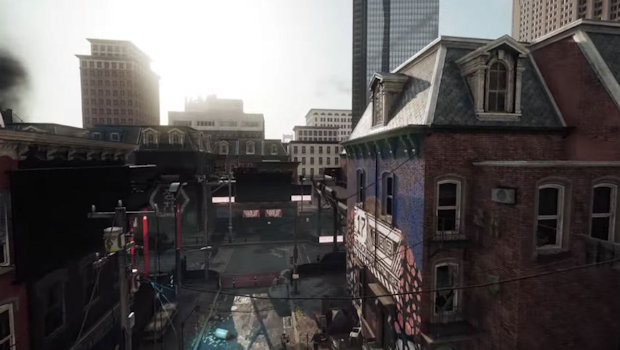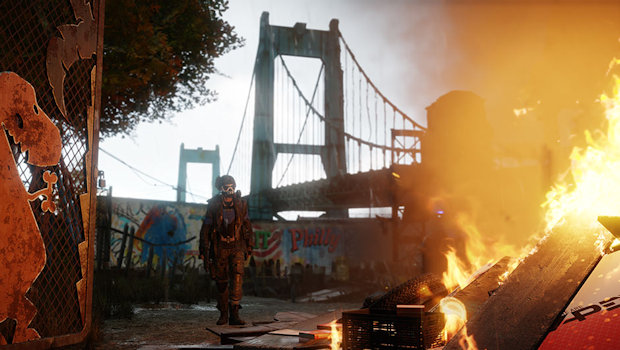In 2011 the extent of publisher THQs financial troubles weren’t visible to the general public but looking back it’s clear that there were three products that the company was betting big on to keep them afloat. The first was the uDraw tablet, released in late 2010 for the WiiU, and late 2011 for the Xbox 360 and Playstation 3. The second was Kaos Studios’ Homefront, with its big draw being that it was written by Red Dawn writer John Milius. And the third was Red Faction: Armageddon, a sequel in a long running THQ franchise.
The uDraw tablet was a complete disaster with it costing THQ roughly $100 million in revenue due to over 1.4 million units just sitting on shelves. Red Faction: Armageddon wasn’t a terrible game but its reception was much weaker than what the company was expecting and the game ultimately killed the franchise. Homefront on the other hand, while not a headlining success for the company, performed well enough commercially for THQ to begin production of a sequel, albeit with a new developer. However, THQ shut down in 2013 and with it Homefront’s sequel went into development limbo. Somehow, someway, Homefront’s sequel has managed to keep its head above water. It has moved around a bit, first to Crytek, then to publisher Deep Silver. Multiple developers have had their hands on it at some point but against all odds, Homefront: The Revolution is here.
The original Homefront was built on a narrative that, while far-fetched, was just believable enough to be terrifying. At the time Homefront released Kim Jong-il was still the supreme ruler of North Korea and the path the game used to get to the future conflict, one where America is overtaken by the despot nation, actually made some sense. The world that Kaos built with the help of Milius was actually pretty intriguing. The rest of the game though was less memorable. It was mostly just a corridor shooter in the style of Call of Duty. Its narrative was super dark and bleak, which isn’t a problem by itself, but when paired with characters that are bombastic, cartoonish, and overtly racist, it made the game a bit hard to play.
Still there was something there in the set-up that made the thought of a sequel interesting. Then they set it in Philadelphia and I was hooked. I live near Philadelphia. I grew up there. It’s my city. Setting a game here is a sure fire way to get me interested in it. Aside from that, Philadelphia is just a great city for this type of game. The streets of Philadelphia are filled with history. In a game with a subtitle of The Revolution, setting it where the United States declared their independence from England seems like a no brainer. It is also a great looking city, with very distinct looking neighborhoods. Homefront: The Revolution was a game filled with promise. Unfortunately, that potential is mostly unfulfilled.
Homefront: The Revolution starts with something of a retcon of the original. The premise stays the same: North Korea has taken over the United States, but how it gets there has changed slightly. On some level it makes sense that you’d change up the set-up; after all it has been five years since the original game released and the world has changed a little in that time. However, the changes they make to the set-up are a bit absurd. Instead of Silicon Valley becoming the world tech hub and Apple becoming the dominant tech company in the world, North Korea and tech company Apex does. Apex creates an iPhone-like device that becomes ubiquitous across the world and brings Korea all sorts of goodwill. Additionally Apex creates weapons and in this world, they somehow get a contract to supply the US military with their weaponry. Except Apex has built a backdoor into the weapons. With the touch of a button Apex shuts down our defenses allowing the Korean People’s Army to just waltz right in and take over. And that brings us here to Philadelphia, where a growing resistance has gained enough of a foothold that it may be able to fight and take back the city for the people.
Let me clarify that for you: a group of freedom fighters is poised to take back one war-torn city on the Eastern seaboard from a tyrannical government. This isn’t a game about a coordinated attack, where the resistance is rising all across America. This is about one city being taken back. One city in between two other major cities (New York and Washington) that are controlled by Korea.
We’ve been groomed to suspend our belief when consuming certain entertainment, so it’s not so much that this approach makes little logical sense that bothers me. It is that the game itself seems to know the approach makes little logical sense. One of the main characters in the narrative is Dr. Sam Burnett. His whole purpose is telling everyone else in the Philly resistance sect that he thinks these are terrible ideas that are going to see a lot of people die. He’s almost always correct and is almost always flat out ignored. Homefront: The Revolution’s message is very clearly that non-violent means of resistance are worthless and to secure freedom we must fight to the death. It’s a shame, because Burnett’s line of reasoning is sound and the game showcases this in other ways as well. But he’s often brushed aside by the other main characters as a pacifist looney and every major resolution in the game involves shooting someone or blowing up something.
Burnett might also be the only character in the game worth liking. The other two main characters, resistance leader Jack Parrish and his right hand, Dana Moore, may be two of the most narrowly focused characters ever created. Their only reason for existing is to inflict damage on the KPA. Parrish is a zealot with a focus on violent rebellion. Moore is just fueled by hatred. That hatred is later explained in the back half of the game with a throwaway line of dialog that heavily implies that she was sexually assaulted and has been seeking revenge on those that violated her. It’s never explored much past that and feels like it was added in just for shock value. Both Parish and Moore are borderline sadistic and they made me feel a bit uncomfortable following their orders, especially with Burnett speaking out against many of their decisions and making sense to me.
But Homefront: The Revolution isn’t a game about choice or player agency. It’s a game about shooting people and blowing things up. And it does these things well enough. Trading in the focused CoD-like structure of the first game, this one borrows heavily from the Far Cry series. The environment is very open and broken up into sectors, of which there are three types of zones. Red zones are non-civilian areas, mostly bombed out sectors of the city where only the KPA patrol. Yellow zones are residential areas, that feature a strong KPA police presence. And the green zone is an area for affluent “traitors” working with and for the KPA.
Most of the game is spent in red and yellow zones and where one ends up is dependent upon where the story is. There isn’t a lot of back and forth between zones, which is good because the load times to get into them are a bit excessive. Red zones normally have you running very specific story missions, with the option to take down KPA outposts during your free time. Yellow zones though are almost always gated zones, meaning a point will be reached where the zone will be required to be liberated. Liberating a yellow zone requires doing enough subversive activities to raise the hearts and minds of the citizens enough to fight back. These subversive activities include damaging KPA infrastructure, assassinating KPA leadership in the zone, rescuing citizens from the KPA, tuning radios into a resistance broadcast, and giving money to beggars. For the activity of rescuing citizens from the KPA, a glitch in the game can be exploited to just keep doing the same event over and over to get the credit for that activity. I wish the rest of the yellow zone liberation activities and much of the rest of the game could be glitched because having to free a zone or run the same type of mission repeatedly is super dull. And they go on for way too long.
In fact, everything in Homefront: The Revolution goes on for way too long. From the load times, to the firefights, to the game’s story, Homefront: The Revolution feels like Return of the King but with bad characters and a motorbike. By the third climax I didn’t care if Philadelphia was attacked with a chemical agent or not; I just wanted Frodo to go home so the credits could roll.
The game doesn’t do itself any favors on the technical front either. It’s filled with excessive load times and some really janky open-world problems. I ran into multiple situations where items would fail to load in, such as vehicles, items floating above the world, or friendlies and enemies getting trapped in geometry. I had one situation where I needed to get out a window to a platform, when I’d melee the window, the glass shattering sound effect would take place but the window would remain and I couldn’t proceed. And worst of all was the persistent freezing where the game would just halt for five or so seconds.
Homefront: The Revolution does do a good job at capturing the look and feel of Philadelphia. While it isn’t a wholly accurate recreation and some things are awkwardly placed, it feels like I was traversing neighborhoods and actual areas in Philadelphia. From South Philly, to Penn’s Landing, to Independence Hall, and City Hall, it all looks and feels right. I wish they did more with the history of Philadelphia and had historic locales and iconic features play a bigger part in the narrative but kudos do need to be handed out to the team’s level designers for hitting it out of the park.
I’d love to recognize the troubled history of the game here more (the game even calls it out before the credits roll) but doing so isn’t fair to anyone. Regardless of the trials and tribulations that took place to get Homefront: The Revolution into our hands, it has to hold its own next to every other game on the market. And it just doesn’t do that. Homefront: The Revolution is a mediocre shooter with overly repetitive missions, a story that makes little logical sense and knows it, and more technical issues than are worth the 20+ hours it will take to get through. I can’t recommend anyway take up the flag of the resistance in Philadelphia.There are just too many other, better games out there to play right now.
This review was written with material provided by the publisher on the Xbox One console. For more on our review process, please read here.


